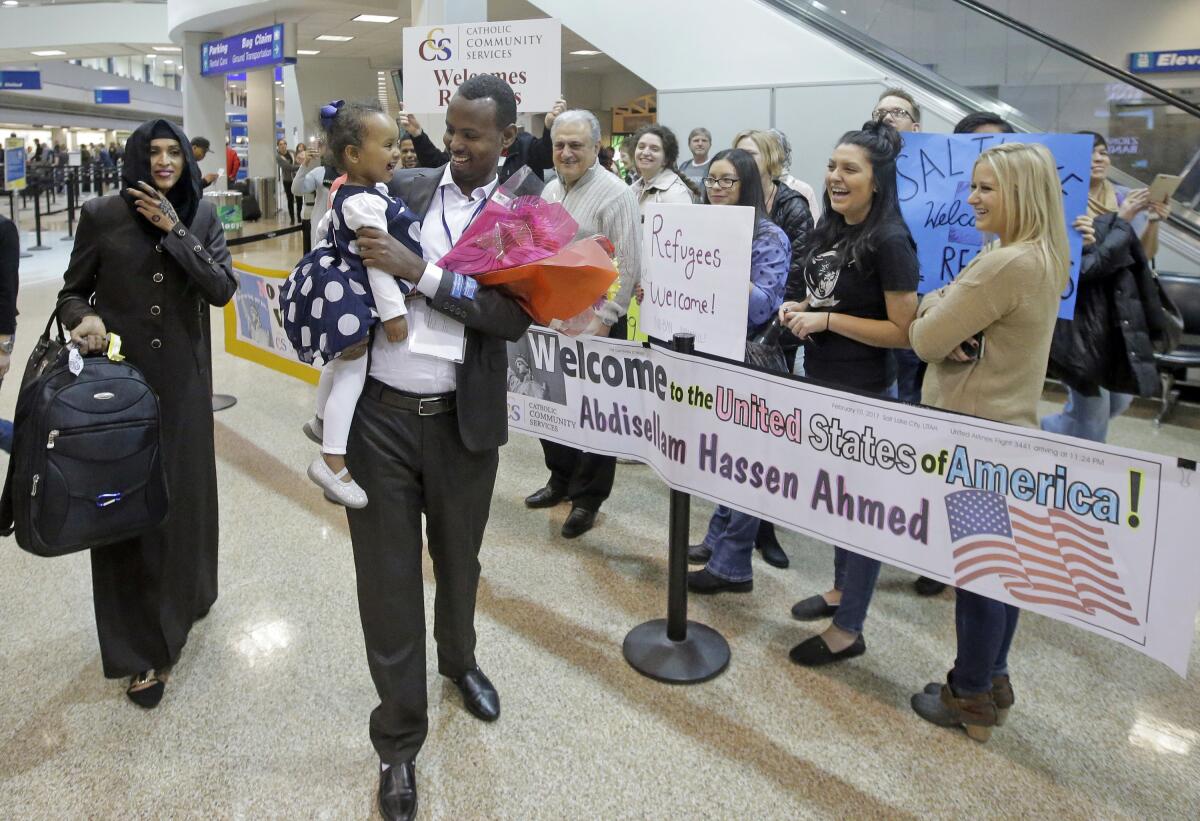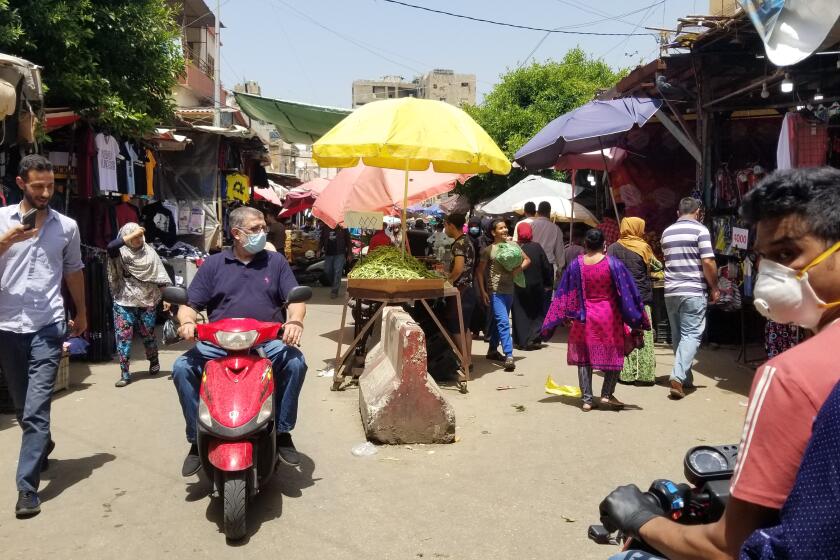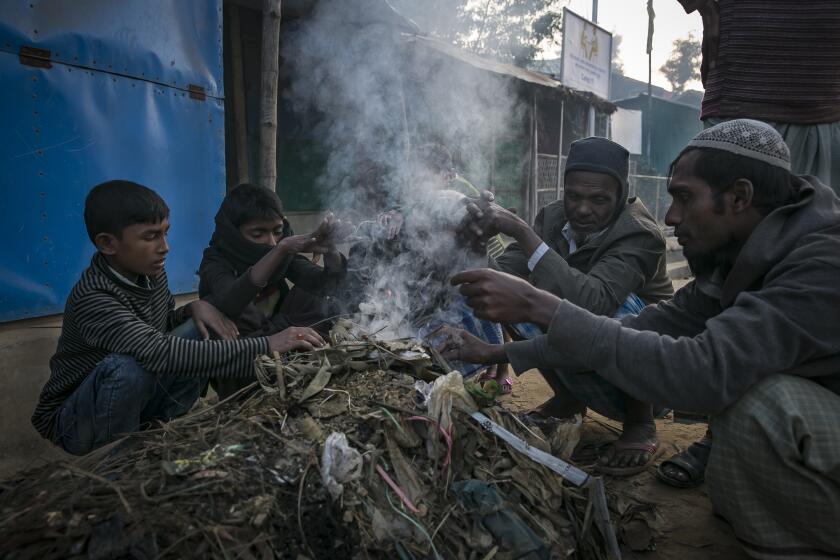Trump plans to slash refugee admissions to U.S. to a new record low

- Share via
SAN DIEGO — The Trump administration has proposed further slashing the number of refugees whom the United States accepts to a new record low in the coming year.
In a notice sent to Congress late Wednesday, just 34 minutes before a statutory deadline to do so, the administration said it intended to admit a maximum of 15,000 refugees in fiscal year 2021. That’s 3,000 fewer than the 18,000 ceiling the administration had set for fiscal year 2020, which expired at midnight Wednesday.
The proposal will now be reviewed by Congress, where there are strong objections to the cuts, but lawmakers will be largely powerless to force changes.
The reduction of more than 16.5% was announced shortly after President Trump vilified refugees as an unwanted burden at a campaign rally in Duluth, Minn., where he assailed his Democratic opponent, former Vice President Joe Biden. He claimed that Biden wanted to flood the state with foreigners.
“Biden will turn Minnesota into a refugee camp, and he said that — overwhelming public resources, overcrowding schools and inundating hospitals. You know that. It’s already there. It’s a disgrace what they’ve done to your state,” Trump told supporters.
Trump froze refugee admissions in March amid the COVID-19 pandemic, citing a need to protect American jobs as the coronavirus crashed the economy.
Reducing refugee quotas, as the president wants to do, would in no way mitigate the border crisis.
Secretary of State Michael R. Pompeo said the administration was committed to the country’s history of leading the world in providing a safe place for refugees.
“We continue to be the single greatest contributor to the relief of humanitarian crisis all around the world, and we will continue to do so,” Pompeo told reporters in Rome on the sidelines of a conference on religious freedom organized by the U.S. Embassy. “Certainly so long as President Trump is in office, I can promise you this administration is deeply committed to that.”
But advocates say the government’s actions do not show that. Since taking office, Trump has slashed the number of refugees allowed into the country by more than 80%, reflecting his broader efforts to drastically reduce both legal and illegal immigration.
The U.S. allowed in just over 10,800 refugees — a little more than half of the 18,000 cap set by Trump for 2020 — before the State Department suspended the program because of the coronavirus.
With 10 million people around the world packed into refugee camps and settlements, advocates fear the onset of an undetected coronavirus crisis.
The 18,000 cap was already the lowest in the history of the program. In addition, the State Department announced last week that it would no longer provide some statistical information on refugee resettlement, sparking more concerns.
Advocates say the Trump administration is dismantling a program that has long enjoyed bipartisan support and has been considered a model for protecting the world’s most vulnerable people. Scores of resettlement offices have closed because of the drop in federal funding, which is tied to the number of refugees placed in the U.S.
The move is reverberating beyond American borders as other countries close their doors to refugees as well.
“We’re talking about tens of millions of desperate families with no place to go and having no hope for protection in the near term,” said Krish Vignarajah, president of the Lutheran Immigration and Refugee Service, a federally funded agency charged with resettling refugees in the U.S.
The world faces a humanitarian crisis of historic proportions propelled by war and political instability, and so far has not devised workable remedies or programs.
Bisrat Sibhatu, an Eritrean refugee, does not want to think about the possibility of another year passing without reuniting with his wife.
For the past two and a half years, he has called the caseworker who helped him resettle in Milwaukee every two weeks to inquire about the status of his wife’s refugee case. The answer is always the same: Nothing to report.
“My wife is always asking me: ‘Is there news?’” said Sibhatu, who talks to her daily over a messaging app. “It’s very tough. How would you feel if you were separated from your husband? It’s not easy. I don’t know what to say to her.”
He said the couple fled Eritrea’s authoritarian government and went to neighboring Ethiopia, which hosts more than 170,000 Eritrean refugees and asylum-seekers. Between 2017 and 2019, his wife, Ruta, was interviewed, vetted and approved to be admitted to the U.S. as a refugee. Then everything came to a halt.
Sibhatu, who works as a machine operator at a spa factory, sends her about $500 every month to cover her living expenses in Ethiopia.
“I worry about her, about her life,” Sibhatu said, noting Ethiopia’s spiraling violence and the pandemic. “But there is nothing we can do.”
He hopes his wife will be among the refugees who make it to the United States in 2021.
More to Read
Sign up for Essential California
The most important California stories and recommendations in your inbox every morning.
You may occasionally receive promotional content from the Los Angeles Times.
















